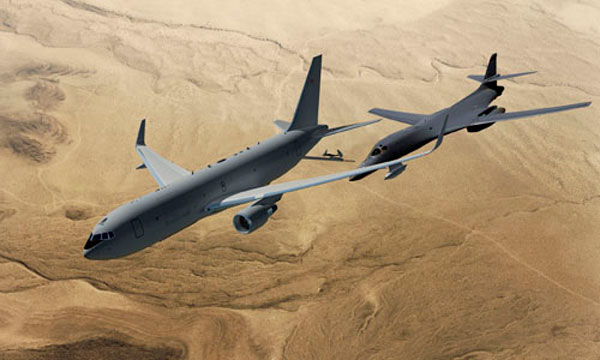
The Boeing KC-46A tanker, which (probably) (this time) won the future yesterday
Yesterday Boeing won a $35 billion contract to replace the Air Force’s Eisenhower-era fleet of refueling tanker planes (picture the lovingly sexualized opening scene of Dr. Strangelove). It’s good news for Chicago, where Boeing is based; better news for Washington State, where the bulk of the company’s jobs and political patrons are located. Tribune reporter Julie Johnsson calls it "a decade-long contracting saga that is one of the lengthiest and strangest in Pentagon history," which is a high bar, but one the tanker mess clears easily.
The contract has now been awarded three times to two different companies over two presidencies: the first was voided after the "dragon lady" set in motion one of the worst pay-for-play scandals in recent political memory with a short phone call, the second after procurement rules and government subsidies touched off an international (and nationally partisan) political fight.
In November, the Washingtonian‘s Shane Harris wrote the most definitive summary of the tanker drama I’ve seen: "not the story of how the US government bought an airplane but how it has failed to buy an airplane."
The first thing you need to know is that the Air Force’s tanker fleet is very old, only slightly newer than the planes my grandfather flew in World War II. In 2009, Noah Shachtman profiled one of the newer ones for Wired, which at the time was only 49 years old. It still had its sextant. Many of the parts are no longer being manufactured, and have to be made from scratch–making the repairs expensive and lengthy, on average 400 days back in 1999. In 2008, a tanker pilot told Reuters that the planes required 10 hours of maintenance for every hour of flight.
In the wake of 9/11, the late Ted Stevens, one of the most powerful men in the Senate (and recipient of campaign cash from Boeing), slipped in a provision to a Defense spending bill to lease planes from Boeing; like all leases, it would cost more over the long run, but America was at war and the commercial airline market was collapsing, so it was explicitly presented as a practical bailout of the manufacturer.
The expensive leasing deal put John McCain on Boeing’s tail, but it might have gone through had the dragon lady–a hard-nosed deputy assistant secretary for acquisitions named Darleen Druyun–not conducted job negotiations with a Boeing executive during the procurement process. She got a $250k job with a $50k signing bonus; Boeing’s end of the deal improved by $6b; and after the story came out, she got nine months in jail, and Boeing’s CEO resigned.
That drama allowed EADS, a big European conglomerate that includes Airbus, to get in on the deal with the help of Northrop Grumman. They pledged to build large portions of the tankers in the US, settling on sites in the anti-union South to compete on cost with Boeing’s unionized employees, and courted southern Republicans like Jeff Sessions and Richard Shelby, in whose state of Alabama EADS would build a big manufacturing plant.
In short, EADS proposed a bigger, more fully featured plane; Boeing proposed a smaller, more efficient one. That gets us up to 2008, seven years after the initial push for the tankers and five years after it fell apart. EADS won. It’s over, right?
Not hardly. By this time it had become a partisan issue, and news that the Air Force would work with a European company over an American one entered the presidential race. Barack Obama and Hillary Clinton called the deal into question, as did Nancy Pelosi and–that guy again–Rahm Emanuel, who both blamed John McCain for sending American jobs overseas. (After yesterday’s news, critics are unsurprisingly charging the Pentagon with protectionism; Shelby is blaming "Chicago politics," because we run everything in these parts.)
Boeing filed a hail-mary protest with the General Accounting Office, and won (PDF). At this point, the 2008 elections were a few months away, and news had come out that John McCain’s top fundraiser was an EADS lobbyist, and the process had gotten politically toxic. So the Pentagon issued a new RFP, which was concluded yesterday.
So now we’re done, right? "’Boeing was a clear winner,’" Deputy Secretary of Defense Bill Lynn told reporters at a press conference," Johnsson’s article says.
But EADS won in a "blow out" three years ago before Boeing’s protest turned the tables (and the rules). Now the Pentagon has a week to explain itself, and EADS has 10 days after that to file its own protest. This being the 21st century, you can follow the massive defense contractor on Twitter.
Rendering: Boeing



